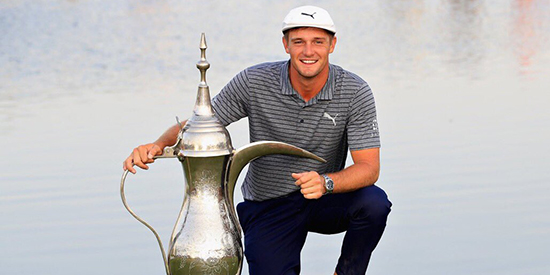Alumni Report: DeChambeau was a scientist even in his am days

Bryson DeChambeau (Twitter photo)
Ever wonder what happens to top amateurs after they pass through the web pages of AmateurGolf.com? Welcome to our series, the Alumni Report. Each week, we’ll profile a former AmateurGolf.com member now navigating the pro waters, providing a progress report and a snapshot of his or her amateur career.
It’s one thing to make middle-of-the-week headlines with unusual statements on everything from club length to protractor use to flagstick strategy. It’s something totally different to be the guy above the fold on Monday morning after logging win after win at the highest level of the game.
Both statements describe
Bryson DeChambeau’s career. Since turning professional in 2016, the 25-year-old has logged five PGA Tour victories. In addition to those, DeChambeau scored his first European Tour win this weekend at the Omega Dubai Desert Classic.
DeChambeau being DeChambeau, this exchange with caddie Tim Tucker may have garnered more attention than the seven-shot victory itself. Easy to see why the player who has risen to No. 5 in the Official World Golf Ranking is often referred to as the Mad Scientist. (Turn your sound on and have a listen.)
Back when he was an amateur, DeChambeau won the 2015 NCAA individual title at SMU, where he majored in physics. Two and a half months after that victory, he also won the U.S. Amateur at Olympia Fields (Ill.) Country Club. Sanctions were imposed on SMU that summer after alleged recruiting violations, and DeChambeau would not have been able to return to the NCAA finals in 2016 if he had returned to college golf. Still, when DeChambeau announced his departure after his junior season, he cited a desire to “prepare myself for the next six months of competition and future events.”
DeChambeau, of course, remained an amateur until April to take advantage of the Masters start he earned by virtue of his U.S. Amateur win, and after a top-25 finish, turned professional the next week at the RBC Heritage and finished T-4. He signed a long-term endorsement deal with Cobra, a company whose equipment he still plays.
Essentially, DeChambeau’s story has been about proving, time and time again, that he really is
that good. After forfeiting the 2016 U.S. Open exemption that also came with that U.S. Am win (he would have had to remain amateur to accept it), DeChambeau advanced through sectional qualifying to earn another spot.
Winning an NCAA title and a U.S. Amateur in such short succession assured that DeChambeau had no shortage of fanfare when he finally did turn professional, but there was already low-key fanfare on the amateur circuit.
Growing up in California, DeChambeau was an early bright spot. He won a Junior Golf Association of Northern California event with a then-personal-best 64 in 2009 when he was just 15. He was runner-up at the California Amateur and the Sahalee Players Championship in 2013 before winning the Trans-Miss Championship later that summer.
During his final summer as an amateur, he scored top-5 finishes at the Southern Amateur and the Pacific Coast Amateur in addition to qualifying for the U.S. Open. He finished one position outside of the 16-man match-play bracket at the Western Amateur.
For all of that, DeChambeau was the
2015 AmateurGolf.com Player of the Year after landing atop the rankings (Jon Rahm, by the way, was second that year).
Results aside, it was hard to miss the player wearing a Ben Hogan cap and talking about every iron in his bag being the same length at his favorite one, the 7-iron. He has been a scientist – albeit a very successful one – all along.